人教PEP版英语五年级下册知识点归纳课件(共33张PPT)
文档属性
| 名称 | 人教PEP版英语五年级下册知识点归纳课件(共33张PPT) | 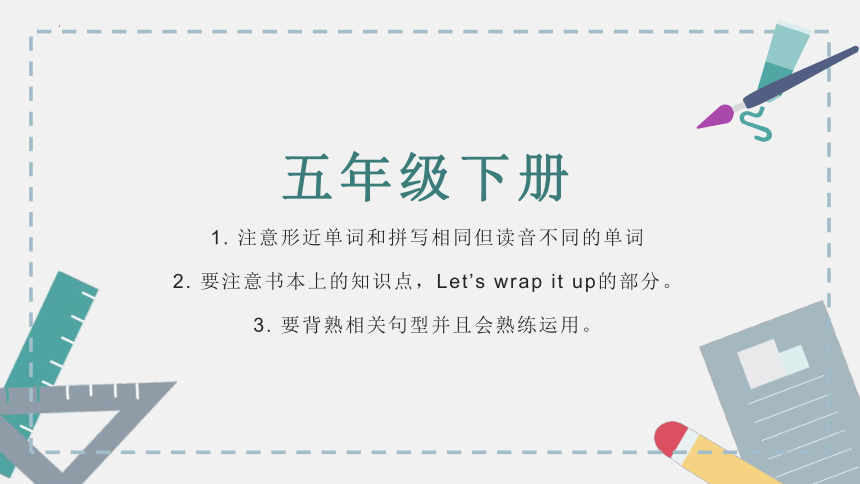 | |
| 格式 | zip | ||
| 文件大小 | 651.3KB | ||
| 资源类型 | 教案 | ||
| 版本资源 | 人教版(PEP) | ||
| 科目 | 英语 | ||
| 更新时间 | 2023-01-09 12:32:06 | ||
图片预览

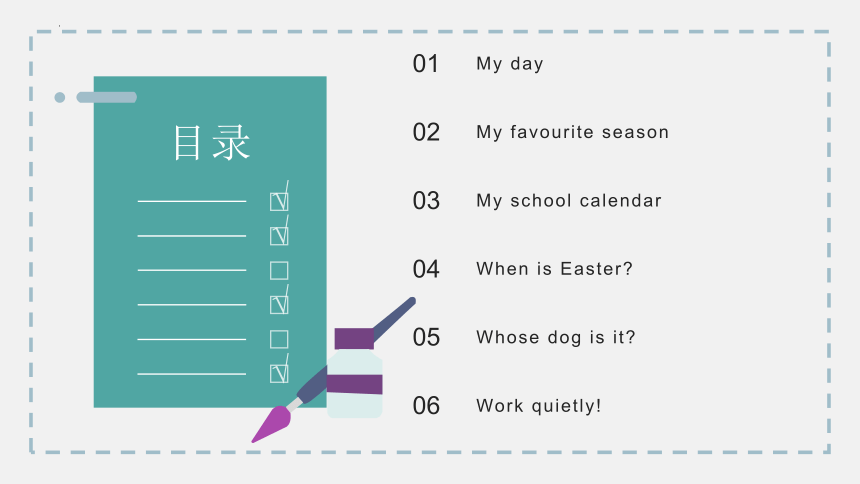
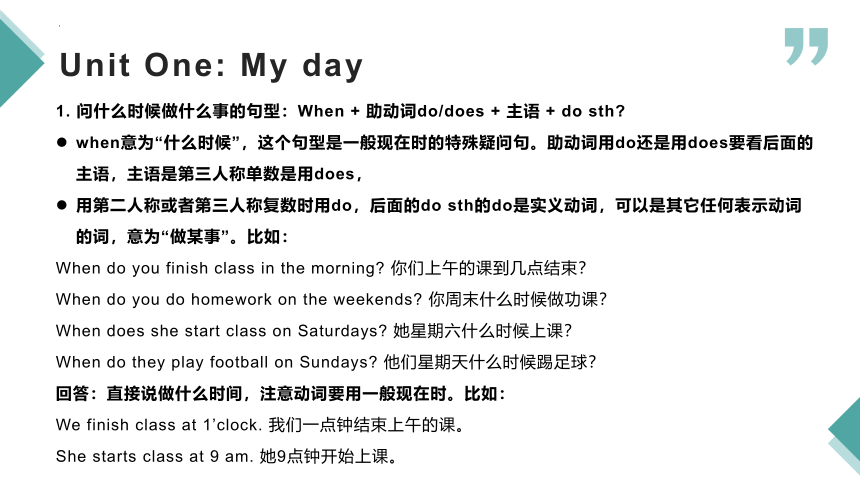
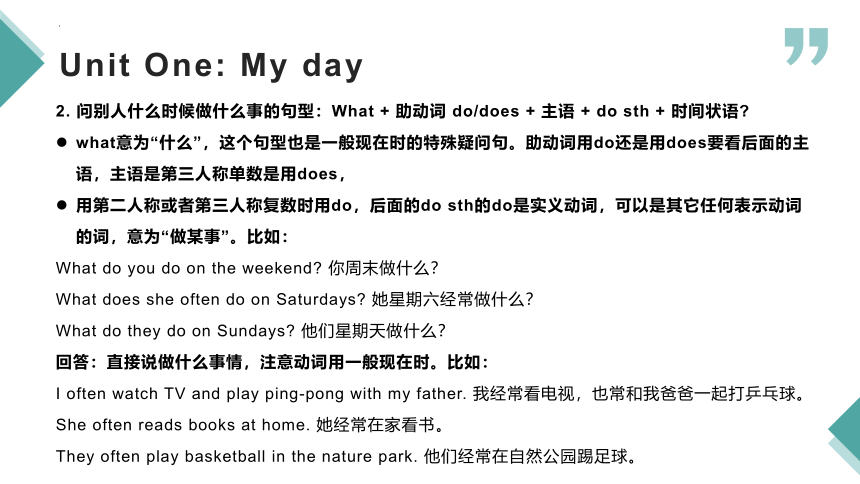
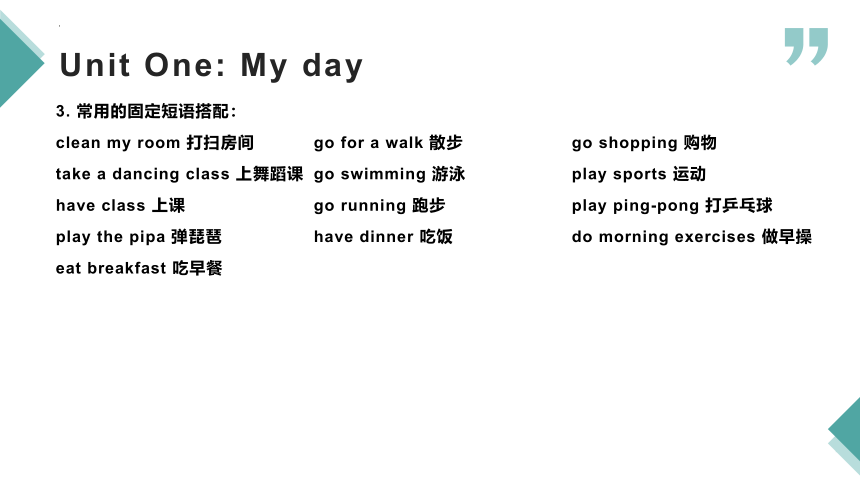
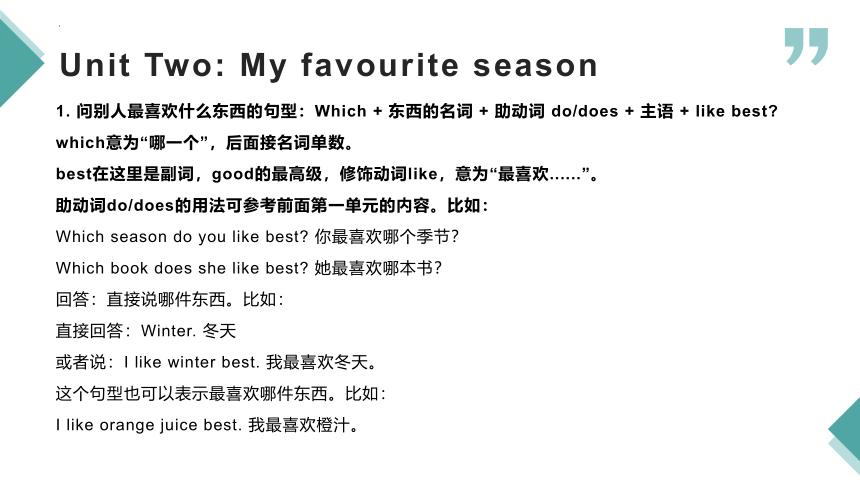
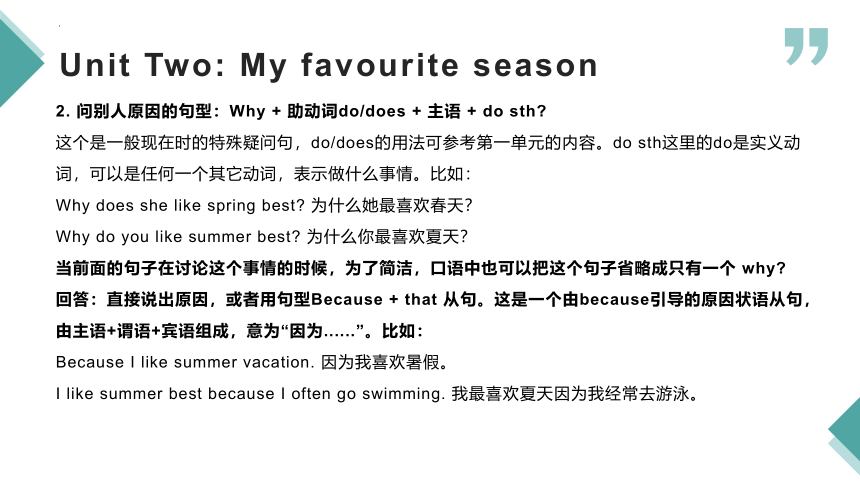
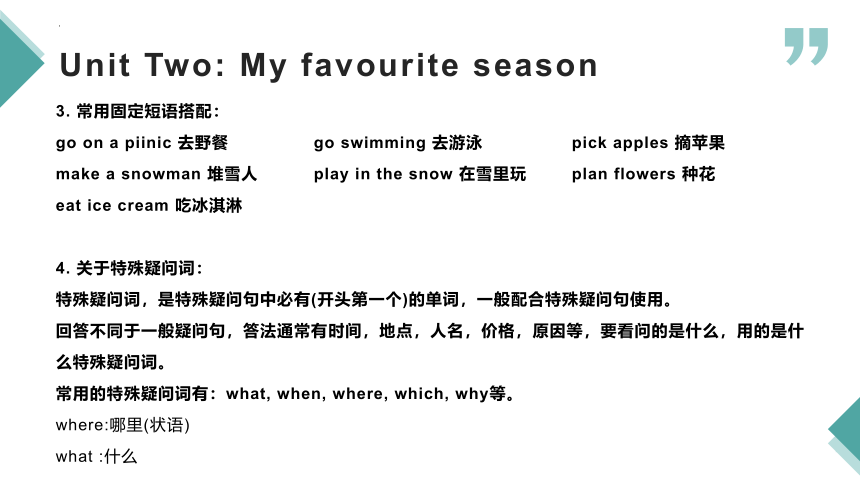

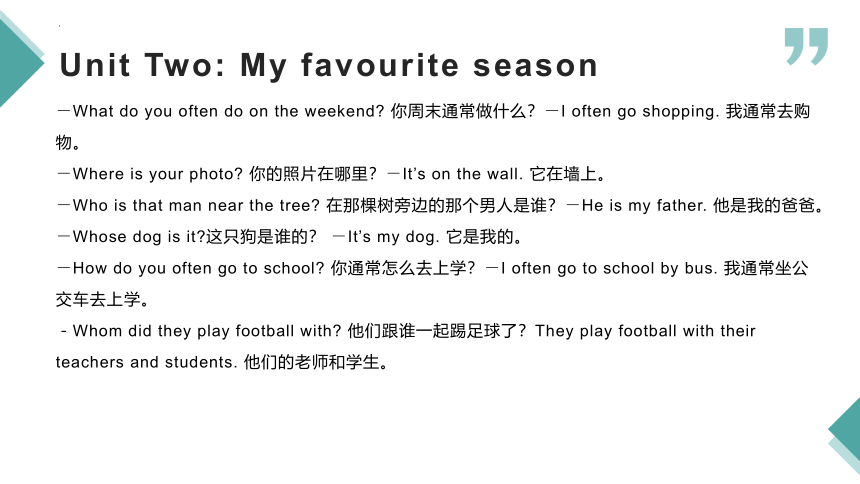
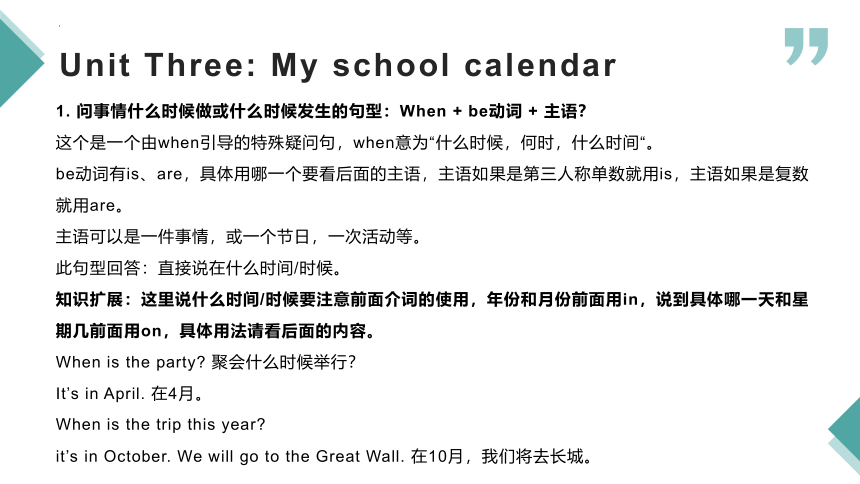
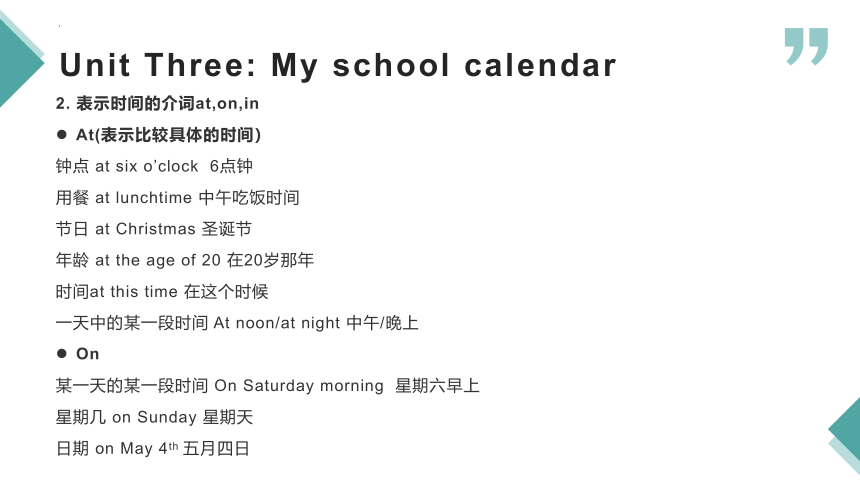
文档简介
(共33张PPT)
五年级下册
1. 注意形近单词和拼写相同但读音不同的单词
2. 要注意书本上的知识点,Let’s wrap it up的部分。
3. 要背熟相关句型并且会熟练运用。
My day
01
My favourite season
02
My school calendar
03
When is Easter
04
Whose dog is it
05
Work quietly!
06
目录
Unit One: My day
1. 问什么时候做什么事的句型:When + 助动词do/does + 主语 + do sth
when意为“什么时候”,这个句型是一般现在时的特殊疑问句。助动词用do还是用does要看后面的主语,主语是第三人称单数是用does,
用第二人称或者第三人称复数时用do,后面的do sth的do是实义动词,可以是其它任何表示动词的词,意为“做某事”。比如:
When do you finish class in the morning 你们上午的课到几点结束?
When do you do homework on the weekends 你周末什么时候做功课?
When does she start class on Saturdays 她星期六什么时候上课?
When do they play football on Sundays 他们星期天什么时候踢足球?
回答:直接说做什么时间,注意动词要用一般现在时。比如:
We finish class at 1’clock. 我们一点钟结束上午的课。
She starts class at 9 am. 她9点钟开始上课。
Unit One: My day
2. 问别人什么时候做什么事的句型:What + 助动词 do/does + 主语 + do sth + 时间状语
what意为“什么”,这个句型也是一般现在时的特殊疑问句。助动词用do还是用does要看后面的主语,主语是第三人称单数是用does,
用第二人称或者第三人称复数时用do,后面的do sth的do是实义动词,可以是其它任何表示动词的词,意为“做某事”。比如:
What do you do on the weekend 你周末做什么?
What does she often do on Saturdays 她星期六经常做什么?
What do they do on Sundays 他们星期天做什么?
回答:直接说做什么事情,注意动词用一般现在时。比如:
I often watch TV and play ping-pong with my father. 我经常看电视,也常和我爸爸一起打乒乓球。
She often reads books at home. 她经常在家看书。
They often play basketball in the nature park. 他们经常在自然公园踢足球。
Unit One: My day
3. 常用的固定短语搭配:
clean my room 打扫房间 go for a walk 散步 go shopping 购物
take a dancing class 上舞蹈课 go swimming 游泳 play sports 运动
have class 上课 go running 跑步 play ping-pong 打乒乓球
play the pipa 弹琵琶 have dinner 吃饭 do morning exercises 做早操
eat breakfast 吃早餐
Unit Two: My favourite season
1. 问别人最喜欢什么东西的句型:Which + 东西的名词 + 助动词 do/does + 主语 + like best
which意为“哪一个”,后面接名词单数。
best在这里是副词,good的最高级,修饰动词like,意为“最喜欢......”。
助动词do/does的用法可参考前面第一单元的内容。比如:
Which season do you like best 你最喜欢哪个季节?
Which book does she like best 她最喜欢哪本书?
回答:直接说哪件东西。比如:
直接回答:Winter. 冬天
或者说:I like winter best. 我最喜欢冬天。
这个句型也可以表示最喜欢哪件东西。比如:
I like orange juice best. 我最喜欢橙汁。
Unit Two: My favourite season
2. 问别人原因的句型:Why + 助动词do/does + 主语 + do sth
这个是一般现在时的特殊疑问句,do/does的用法可参考第一单元的内容。do sth这里的do是实义动词,可以是任何一个其它动词,表示做什么事情。比如:
Why does she like spring best 为什么她最喜欢春天?
Why do you like summer best 为什么你最喜欢夏天?
当前面的句子在讨论这个事情的时候,为了简洁,口语中也可以把这个句子省略成只有一个 why
回答:直接说出原因,或者用句型Because + that 从句。这是一个由because引导的原因状语从句,由主语+谓语+宾语组成,意为“因为......”。比如:
Because I like summer vacation. 因为我喜欢暑假。
I like summer best because I often go swimming. 我最喜欢夏天因为我经常去游泳。
Unit Two: My favourite season
3. 常用固定短语搭配:
go on a piinic 去野餐 go swimming 去游泳 pick apples 摘苹果
make a snowman 堆雪人 play in the snow 在雪里玩 plan flowers 种花
eat ice cream 吃冰淇淋
4. 关于特殊疑问词:
特殊疑问词,是特殊疑问句中必有(开头第一个)的单词,一般配合特殊疑问句使用。
回答不同于一般疑问句,答法通常有时间,地点,人名,价格,原因等,要看问的是什么,用的是什么特殊疑问词。
常用的特殊疑问词有:what, when, where, which, why等。
where:哪里(状语)
what :什么
Unit Two: My favourite season
when:问时间 (回答用At/ On...等)
which:哪一个,哪个
why: 为什么 (回答用Because,问原因)
who :谁 ( 回答用He is...She is... They are...等)
whom: 谁(宾格)
whose:谁的 (回答用It is.. These/Those are等)
How:怎么样(回答用形容词,问程度,也可搭配其它单词表示其它意思,比如how much问多少钱等)
相关句型与回答如下:
-Why do you like spring best 你为什么最喜欢春天?-Because the weather is nice.因为春天的天气很好。
-Which season do you like best 你最喜欢哪个季节?- I like spring best. 我最喜欢春天。
-When do you go to school 你什么时候上学?-I go to school at 8’clock.我8点钟上学。
Unit Two: My favourite season
-What do you often do on the weekend 你周末通常做什么?-I often go shopping. 我通常去购物。
-Where is your photo 你的照片在哪里?-It’s on the wall. 它在墙上。
-Who is that man near the tree 在那棵树旁边的那个男人是谁?-He is my father. 他是我的爸爸。
-Whose dog is it 这只狗是谁的? -It’s my dog. 它是我的。
-How do you often go to school 你通常怎么去上学?-I often go to school by bus. 我通常坐公交车去上学。
-Whom did they play football with 他们跟谁一起踢足球了?They play football with their teachers and students. 他们的老师和学生。
Unit Three: My school calendar
1. 问事情什么时候做或什么时候发生的句型:When + be动词 + 主语?
这个是一个由when引导的特殊疑问句,when意为“什么时候,何时,什么时间“。
be动词有is、are,具体用哪一个要看后面的主语,主语如果是第三人称单数就用is,主语如果是复数就用are。
主语可以是一件事情,或一个节日,一次活动等。
此句型回答:直接说在什么时间/时候。
知识扩展:这里说什么时间/时候要注意前面介词的使用,年份和月份前面用in,说到具体哪一天和星期几前面用on,具体用法请看后面的内容。
When is the party 聚会什么时候举行?
It’s in April. 在4月。
When is the trip this year
it’s in October. We will go to the Great Wall. 在10月,我们将去长城。
Unit Three: My school calendar
2. 表示时间的介词at,on,in
At(表示比较具体的时间)
钟点 at six o’clock 6点钟
用餐 at lunchtime 中午吃饭时间
节日 at Christmas 圣诞节
年龄 at the age of 20 在20岁那年
时间at this time 在这个时候
一天中的某一段时间 At noon/at night 中午/晚上
On
某一天的某一段时间 On Saturday morning 星期六早上
星期几 on Sunday 星期天
日期 on May 4th 五月四日
Unit Three: My school calendar
节假日 on New Year’s Day 新年
In(比较大的时间)
一天中某一段时间
In the morning/afternoon/evening 早上/中午/晚上
月份:in April 四月份
季节:in spring 春天
年份:in 2019 2019年
相关句型如下:
We will have an English party in February. 2月份我们将举办英语晚会。
I get up at 7’clock every day. 我每天7点起床。
What do you have on Tuesday 你们星期二有什么课?
Unit Three: My school calendar
3. 固定短语搭配:
cook for my mother 煮饭给我妈妈吃 make a card 制作卡片 sing to her 为她唱歌
say “Thank you” 说谢谢 write her a letter 给她写信
tell her a story 为她讲个故事 play the pipa for her 为她弹琵琶
play games 玩游戏 make a wish 许愿
sing the birthday song 唱生日歌 eat noodles 吃面条
eat a birthday cake 吃生日蛋糕
4. 月份的单词、有缩写的缩写形式以及每个月的相关节假日:
January(Jan.): New Year’s Day 新年,winter vacation 寒假
February(Feb.): winter vacation 寒假
March(Mar.): Tree PLanting Day 植树节
Unit Three: My school calendar
April(Apr.): Easter day 复活节,April Fool’s Day 愚人节
May: May Day 劳动节,Mother’s Day 母亲节
June(Jun.): Children’s Day 儿童节,Father’s Day 父亲节
July(Jul.): summer vacation 暑假
August(Aug.): summer vacation 暑假
September(Sep.): Teacher’s Day 教师节,Mid-Autumn Day 中秋节
October(Oct.): China’s National Day 中国的国庆
November(Nov.): American Thanksgiving Day 美国的感恩节
December(Dec.): Christmas 圣诞节
Unit Four: When is Easter
1. 问节日是在哪一天的句型:When is + 节日?比如:
When is April Fool’s Day 愚人节是哪一天?
It’s on April 1st. 它在4月1日。
注意:回答的时间说具体哪一天即哪月哪日,前面的介词要用on。还要注意几月几日的写法。
2.问生日是哪一天的句型:When is + 形容词性物主代词(表示所有格) + birthday
形容词性物主代词有:your, his, her, their, its, my等,具体可参考前面的知识点。
如果是问两个或者两个人以上的生日,is要变成are,birthday要加s变成birthdays。
回答:可以说具体哪一天即哪月哪日,介词用on。比如:
When is your birthday 你的生日是哪天?
My birthday is on April 4th.
When are their birthdays 他们的生日是哪天?
Their birthdays are on April 4th and Jan. 5th.
Unit Four: When is Easter
3. 基数词和序数词:
基数词:表示数目/数量,意为”几个“。下面是基数词的构成表,可着重看1-99的。
范围 特点 实例
1-12 无规律 one, two, three, four, five, six, seven, eight, nine, ten, eleven, twelve
13-19 以teen结尾 thirteen, fourteen, fifiteen, sixteen, seventeen, eighteen, nineteen
20-90 以ty结尾 twenty, thirty, forty, fifty, sixty, seventy, eighty, ninety
21-99 十位与个位之间要加连字符"-" twenty-five, sixty-five, forty-nine
101-99 百位与个位之前通常要用and three hundred and twenty-five (美语中常将and省略)
千以上 6275---six thousand two hundred and seventy-five; 1200---twelve hundred(one thousand two hundred) 155,721---one hundred(and)fifly-five thousand seven hundred(and)twenty-one
Unit Four: When is Easter
3. 基数词和序数词:
序数词:表示事物的顺序,意为“第几个”。序数词构成表如下:
范围 特点 实例
1-19 各基数词词尾加th four -- fourth, six -- sixth
nineteen -- nineteenth
七个例外 one -- first, two -- second, three -- third,
five -- fifth, eight -- eighth,
nine -- ninth, twelve -- twelfth
20,30-90 把y改i之后加eth twenty -- twentieth,
forty -- fortieth
ninety -- ninetieth
21以后多位数 最后一个数用序数词,其余用基数词 第21 - twenty-first, 第110 - one hundred and tenth
Unit Four: When is Easter
1-10的基数词和序数词对照表,其中序数词是缩写。
相关的例句及数词的正确形式如下:
I see ten horses in the picture.(ten) 我看见画里有10匹马。
My birthday is on July 2nd. (two) 我的生日在7月2日。
Mother’s Day is on the 2nd Sunday in May. (two) 母亲节是在五月的第二个星期天。
It is three o’clock. (three) 现在是3点钟。
There are eight people in his family. (eight) 他家有8个人。
one two three four five six seven eight nine ten
1st 2nd 3rd 4th 5th 6th 7th 8th 9th 10th
Unit Four: When is Easter
4. 基数词变序数词的口诀(规律)
基变序,有规律,一般词尾th。
一二三,特殊记,词尾字母ddt (third,second, first)。
八减t(eighth), 九去e(ninth),f来把ve替(five-fifth, twelve-twelfth)。
若是ty作结尾,ty就变tie,最后再加 th(twenty-twentieth)
若是碰到几十几,只变个位就可以。
第一百、第一千、第一万、第一百万、第十亿都是在基数词后面
直接加 th 构成。如:hundred - hundredth, thousand - thousandth
序数词的缩略形式是由阿拉伯数字 序数词的最后两个字母构成。如
第25,twenty-fifth = 25th
序数词前面要加定冠词 如:She is always the first one to go to school.
Unit Four: When is Easter
5. 基数词的常见基本用法
表示年、月、日
2008年12月25日:December 25th, 2008 读作:December the twenty-fifth two thousand and eight
12个月:twelve month
11天:eleven days
15岁: fifteen years old
表示时刻
8:21 读作 twenty-one past eight / eight twenty-one
7:30 读作 half past seven / seven thirty
14:50 读作 fourteen fifty / ten to fifteen
16:00 读作 sixteen o’clock / sixteen
Unit Four: When is Easter
5. 序数词的常见基本用法
表示日期
3月8日 March 8th 读作 March the eighth
1986年9月1日 September 1st, 1986 / 1st September, 1986
表示分数(分子用基数,分母用序数,分子大于1,分线用复数)
1/6 one sixth 3/5 three fifths 3/37 three thirty-seventh
1/3 one third 2/3 two thirds
表示楼层 。地面之上的部分,序数词+floor
但是英美习惯不同,British convention有Ground floor第一层,再上一层是first floor,American convention通常不使用Ground floor,第一层就是first floor,再上一层是second floor。
Unit Five: Whose dog is it
1. 表示东西是谁的句型:主语 + be动词 + 名词性物主代词。
此句型用名词性物主代词,句中的主语必须是前面已经讲到或提过的东西。
be动词有is、are,具体用哪一个要看前面的主语,主语是第三人称单数,就用is。主语是复数,就用are。
此句型可以作为肯定句使用,也可用于回答问东西是谁的句型。
相关例句如下:
The yellow picture is mine. 那幅黄色的画是我的。
-Whose is it 这是谁的?- It’s Zhngpeng’s. 是张鹏的。
-Whose storybooks are these 这些故事书是谁的?-They are mine. 他们是我的。
-Whose book is this 这本书是谁的?-It’s Mike’s. It’s his. 是迈克的,是他的。
2. 问东西是谁的吗的一般疑问句的句型:be动词 + 主语 + 名词性物主代词?
此处回答要注意:主语不可以用these/those或者this/that等指示代词,要用人称代词they/it等。比如:
Unit Five: Whose dog is it
Are these all ours 这些都是我们的吗?
回答:肯定回答:Yes, they are.
否定回答:No, they aren’t.
Is this hers 这个是她的吗?
Yes, it is. 是的。
No, it isn’t. 不,不是的。
3. 问某人正在做什么吗的一般疑问句的句型:be动词 + 主语 + 动词ing的形式 + (sth)
be动词的用法看后面的主语是单数还是复数
动词ing的形式表示问的时候动作正在进行时
回答:肯定回答:Yes, 主语 + be动词 + 动词ing的形式 + (sth).
否定回答:No, 主语 + be动词 + not + 动词ing的形式 + (sth)
Is he drinking water 它在喝水吗?
No, he isn’t. He is eating. 不是,它在吃东西。
Unit Five: Whose dog is it
4. 常用表示动作的单词的现在进行时:
sleep - sleeping 睡觉 run - running 跑步 read - reading 读书
jump - jumping 跳 play - playing 玩 climb - climbing 爬
listen - listening 听 eat - eating 吃 drink - drinking 喝
5. 物主代词:
物主代词就是表示所有关系的代词,也叫人称代词的所有格。意为“谁的东西”。
物主代词分为形容词性物主代词和名词性物主代词两种。
形容词性物主代词:后面+名词
名词性物主代词(mine/yours/his/hers/its/ours/theirs):相当于形容词性物主代词+名词,故其后不用加名词。如:Is this your book No, it isn’t. it’s hers (her book),
物主代词的分类如下:
Unit Five: Whose dog is it
单数 复数 第一人称 第二人称 第三人称 第一人称 第二人称 第三人称
形容词性物主代词 my your his her its our your their
名词性物主代词 mine yours his hers its ours yours theirs
中文 我的 你的 他的 她的 它的 我们的 你们的 他(她、它)
相关例句如下,注意代词的用法。
Amy: Whose English book is that 那是谁的英语书?
John: It’s Miss White’s book. It is hers. 是怀特小姐的书,是她的。
Amy: Whose story book is this 这是谁的故事书?
John: It’s Zhang Peng’s. It’s his. 是张鹏的,是他的。
Unit Five: Whose dog is it
Wu Yifan: Where is my pen I can’t find it. 我的钢笔在哪呢?我找不到它。
Sarah: Here’s one. Is this your pen 这里有一支,是你的钢笔吗?
Wu Yifan: Yes, it’s mine. Thank you. 是的,它是我的,谢谢。
Grandpa: Whose rabbits are these 这些兔子是谁的?
Robin: These are Wu Binbin’s.是吴彬彬的。
Grandpa: Oh, these are his rabbits. 哦,这些是他的兔子。
Robin: Look! The rabbits are eating their carrots now. 看!兔子在吃它们的胡萝卜。
Mike: Mum, my dog is so cute. I love him so much. 妈妈,我的狗太可爱了,我好喜欢它。
Mum: My dear, it’s not only your dog. It’s also mine. 亲爱的,这不止是你的狗,它也是我的。
Mike: Yes, mum. He’s our dog. 是的,妈妈,它是我们的狗。
Unit Six: Work quietly!
1. 问别人正在做什么的句型:What + be动词 + 主语 + 动词ing形式?
这是一个由what引导的特殊疑问句,并且是现在进行时的,表示说话的时候动作正在进行。
be动词有is、are,用哪一个要看后面的主语,主语是单数用is,主语是复数用are。
回答也要用现在进行时。比如:
What are they doing 他们在干什么?
They’re eating lunch. 他们在吃午饭。
What’s the little monkey doing 那只小猴子在干什么?
It’s playing with its mother! 它在和妈妈玩耍。
2. 更多常用动词的现在进行时:
speak - speaking 讲话 say - saying 说话 draw - drawing 画画
cook - cooking 烹饪 do - doing 做某事 talk - talking 谈话
play - playing 玩 colour - colouring 上色 write - writing 写字
walk - walking 步行,散步 have - having 上....(课) clean - cleaning 打扫
watch - watching 看
Unit Six: Work quietly!
3. 祈使句:
祈使句(Imperative Sentence)是英语中的一个句式,也是用于表达命令、请求、劝告、警告、禁止等的句子。祈使句最常用于表达命令,因此在学校文法中也常称为命令句。
在祈使句中,通常省略第二人称主语you,肯定式以动词原形开头,否定式在动词原形前加don’t. 如:
Work quietly! 安静地做事!
Talk quietly! 悄悄地说话!
Keep your desk clean! 桌子保持干净!
No eating! 禁止饮食!
Keep to the right! 靠右走!
Take turns! 轮流来!
为表示礼貌,祈使句中经常在句首或句末加please。句末加please时,前面通常加逗号。比如:
Quiet, please! 请安静!
Come in, please! 请进来!
Please take turns! 请排队!
Unit Six: Work quietly!
4. 现在进行时:
现在进行时表示现在(说话瞬间)正在进行或者发生的动作。如:
The students are listening to the teacher.
He is watching TV now.
也可以表示当前一段时间内的活动或者现阶段正在进行的动作。如:
We are working on a farm these days.
I’m reading a history book this month.
现在进行时是由助动词be(am/is/are)加动词-ing形式构成的,以动词
work为例,现在进行时的肯定式,否定式,疑问式和简略答语如下:
肯定式 否定式
I am working. He/She is working. We/You/They are working. I am not working.
He/She is not working.
We/You/They are not working.
Unit Six: Work quietly!
疑问式和简略答语 Am I working Yes, you are. No, you are not(aren’t). Are we working
Yes, we are.
No, we are not(aren’t).
Are you working Yes, I am. No, I am not. Are you working
Yes, we are.
No, we are not(aren’t).
Is he/she working Yes, he/she is. No, he/she is not(isn’t). Are they working
Yes, they are.
No, they are not(aren’t).
Unit Six: Work quietly!
现在进行时-动词ing形式的构成
类别 构成方法 读音
一般情况 加 -ing Go---going
Ask---asking
Look---looking
以不发间e字母结尾的动词 去掉e,再加 -ing Write--writing
Make--making
Take-taking
以重读闭音节结尾的动词,末尾只有一个辅音字母 双写这个辅音字母,再加ing Get--getting
Sit--sitting
Put--putting
Run-running
Begin-beginning
谢谢观看
五年级下册
1. 注意形近单词和拼写相同但读音不同的单词
2. 要注意书本上的知识点,Let’s wrap it up的部分。
3. 要背熟相关句型并且会熟练运用。
My day
01
My favourite season
02
My school calendar
03
When is Easter
04
Whose dog is it
05
Work quietly!
06
目录
Unit One: My day
1. 问什么时候做什么事的句型:When + 助动词do/does + 主语 + do sth
when意为“什么时候”,这个句型是一般现在时的特殊疑问句。助动词用do还是用does要看后面的主语,主语是第三人称单数是用does,
用第二人称或者第三人称复数时用do,后面的do sth的do是实义动词,可以是其它任何表示动词的词,意为“做某事”。比如:
When do you finish class in the morning 你们上午的课到几点结束?
When do you do homework on the weekends 你周末什么时候做功课?
When does she start class on Saturdays 她星期六什么时候上课?
When do they play football on Sundays 他们星期天什么时候踢足球?
回答:直接说做什么时间,注意动词要用一般现在时。比如:
We finish class at 1’clock. 我们一点钟结束上午的课。
She starts class at 9 am. 她9点钟开始上课。
Unit One: My day
2. 问别人什么时候做什么事的句型:What + 助动词 do/does + 主语 + do sth + 时间状语
what意为“什么”,这个句型也是一般现在时的特殊疑问句。助动词用do还是用does要看后面的主语,主语是第三人称单数是用does,
用第二人称或者第三人称复数时用do,后面的do sth的do是实义动词,可以是其它任何表示动词的词,意为“做某事”。比如:
What do you do on the weekend 你周末做什么?
What does she often do on Saturdays 她星期六经常做什么?
What do they do on Sundays 他们星期天做什么?
回答:直接说做什么事情,注意动词用一般现在时。比如:
I often watch TV and play ping-pong with my father. 我经常看电视,也常和我爸爸一起打乒乓球。
She often reads books at home. 她经常在家看书。
They often play basketball in the nature park. 他们经常在自然公园踢足球。
Unit One: My day
3. 常用的固定短语搭配:
clean my room 打扫房间 go for a walk 散步 go shopping 购物
take a dancing class 上舞蹈课 go swimming 游泳 play sports 运动
have class 上课 go running 跑步 play ping-pong 打乒乓球
play the pipa 弹琵琶 have dinner 吃饭 do morning exercises 做早操
eat breakfast 吃早餐
Unit Two: My favourite season
1. 问别人最喜欢什么东西的句型:Which + 东西的名词 + 助动词 do/does + 主语 + like best
which意为“哪一个”,后面接名词单数。
best在这里是副词,good的最高级,修饰动词like,意为“最喜欢......”。
助动词do/does的用法可参考前面第一单元的内容。比如:
Which season do you like best 你最喜欢哪个季节?
Which book does she like best 她最喜欢哪本书?
回答:直接说哪件东西。比如:
直接回答:Winter. 冬天
或者说:I like winter best. 我最喜欢冬天。
这个句型也可以表示最喜欢哪件东西。比如:
I like orange juice best. 我最喜欢橙汁。
Unit Two: My favourite season
2. 问别人原因的句型:Why + 助动词do/does + 主语 + do sth
这个是一般现在时的特殊疑问句,do/does的用法可参考第一单元的内容。do sth这里的do是实义动词,可以是任何一个其它动词,表示做什么事情。比如:
Why does she like spring best 为什么她最喜欢春天?
Why do you like summer best 为什么你最喜欢夏天?
当前面的句子在讨论这个事情的时候,为了简洁,口语中也可以把这个句子省略成只有一个 why
回答:直接说出原因,或者用句型Because + that 从句。这是一个由because引导的原因状语从句,由主语+谓语+宾语组成,意为“因为......”。比如:
Because I like summer vacation. 因为我喜欢暑假。
I like summer best because I often go swimming. 我最喜欢夏天因为我经常去游泳。
Unit Two: My favourite season
3. 常用固定短语搭配:
go on a piinic 去野餐 go swimming 去游泳 pick apples 摘苹果
make a snowman 堆雪人 play in the snow 在雪里玩 plan flowers 种花
eat ice cream 吃冰淇淋
4. 关于特殊疑问词:
特殊疑问词,是特殊疑问句中必有(开头第一个)的单词,一般配合特殊疑问句使用。
回答不同于一般疑问句,答法通常有时间,地点,人名,价格,原因等,要看问的是什么,用的是什么特殊疑问词。
常用的特殊疑问词有:what, when, where, which, why等。
where:哪里(状语)
what :什么
Unit Two: My favourite season
when:问时间 (回答用At/ On...等)
which:哪一个,哪个
why: 为什么 (回答用Because,问原因)
who :谁 ( 回答用He is...She is... They are...等)
whom: 谁(宾格)
whose:谁的 (回答用It is.. These/Those are等)
How:怎么样(回答用形容词,问程度,也可搭配其它单词表示其它意思,比如how much问多少钱等)
相关句型与回答如下:
-Why do you like spring best 你为什么最喜欢春天?-Because the weather is nice.因为春天的天气很好。
-Which season do you like best 你最喜欢哪个季节?- I like spring best. 我最喜欢春天。
-When do you go to school 你什么时候上学?-I go to school at 8’clock.我8点钟上学。
Unit Two: My favourite season
-What do you often do on the weekend 你周末通常做什么?-I often go shopping. 我通常去购物。
-Where is your photo 你的照片在哪里?-It’s on the wall. 它在墙上。
-Who is that man near the tree 在那棵树旁边的那个男人是谁?-He is my father. 他是我的爸爸。
-Whose dog is it 这只狗是谁的? -It’s my dog. 它是我的。
-How do you often go to school 你通常怎么去上学?-I often go to school by bus. 我通常坐公交车去上学。
-Whom did they play football with 他们跟谁一起踢足球了?They play football with their teachers and students. 他们的老师和学生。
Unit Three: My school calendar
1. 问事情什么时候做或什么时候发生的句型:When + be动词 + 主语?
这个是一个由when引导的特殊疑问句,when意为“什么时候,何时,什么时间“。
be动词有is、are,具体用哪一个要看后面的主语,主语如果是第三人称单数就用is,主语如果是复数就用are。
主语可以是一件事情,或一个节日,一次活动等。
此句型回答:直接说在什么时间/时候。
知识扩展:这里说什么时间/时候要注意前面介词的使用,年份和月份前面用in,说到具体哪一天和星期几前面用on,具体用法请看后面的内容。
When is the party 聚会什么时候举行?
It’s in April. 在4月。
When is the trip this year
it’s in October. We will go to the Great Wall. 在10月,我们将去长城。
Unit Three: My school calendar
2. 表示时间的介词at,on,in
At(表示比较具体的时间)
钟点 at six o’clock 6点钟
用餐 at lunchtime 中午吃饭时间
节日 at Christmas 圣诞节
年龄 at the age of 20 在20岁那年
时间at this time 在这个时候
一天中的某一段时间 At noon/at night 中午/晚上
On
某一天的某一段时间 On Saturday morning 星期六早上
星期几 on Sunday 星期天
日期 on May 4th 五月四日
Unit Three: My school calendar
节假日 on New Year’s Day 新年
In(比较大的时间)
一天中某一段时间
In the morning/afternoon/evening 早上/中午/晚上
月份:in April 四月份
季节:in spring 春天
年份:in 2019 2019年
相关句型如下:
We will have an English party in February. 2月份我们将举办英语晚会。
I get up at 7’clock every day. 我每天7点起床。
What do you have on Tuesday 你们星期二有什么课?
Unit Three: My school calendar
3. 固定短语搭配:
cook for my mother 煮饭给我妈妈吃 make a card 制作卡片 sing to her 为她唱歌
say “Thank you” 说谢谢 write her a letter 给她写信
tell her a story 为她讲个故事 play the pipa for her 为她弹琵琶
play games 玩游戏 make a wish 许愿
sing the birthday song 唱生日歌 eat noodles 吃面条
eat a birthday cake 吃生日蛋糕
4. 月份的单词、有缩写的缩写形式以及每个月的相关节假日:
January(Jan.): New Year’s Day 新年,winter vacation 寒假
February(Feb.): winter vacation 寒假
March(Mar.): Tree PLanting Day 植树节
Unit Three: My school calendar
April(Apr.): Easter day 复活节,April Fool’s Day 愚人节
May: May Day 劳动节,Mother’s Day 母亲节
June(Jun.): Children’s Day 儿童节,Father’s Day 父亲节
July(Jul.): summer vacation 暑假
August(Aug.): summer vacation 暑假
September(Sep.): Teacher’s Day 教师节,Mid-Autumn Day 中秋节
October(Oct.): China’s National Day 中国的国庆
November(Nov.): American Thanksgiving Day 美国的感恩节
December(Dec.): Christmas 圣诞节
Unit Four: When is Easter
1. 问节日是在哪一天的句型:When is + 节日?比如:
When is April Fool’s Day 愚人节是哪一天?
It’s on April 1st. 它在4月1日。
注意:回答的时间说具体哪一天即哪月哪日,前面的介词要用on。还要注意几月几日的写法。
2.问生日是哪一天的句型:When is + 形容词性物主代词(表示所有格) + birthday
形容词性物主代词有:your, his, her, their, its, my等,具体可参考前面的知识点。
如果是问两个或者两个人以上的生日,is要变成are,birthday要加s变成birthdays。
回答:可以说具体哪一天即哪月哪日,介词用on。比如:
When is your birthday 你的生日是哪天?
My birthday is on April 4th.
When are their birthdays 他们的生日是哪天?
Their birthdays are on April 4th and Jan. 5th.
Unit Four: When is Easter
3. 基数词和序数词:
基数词:表示数目/数量,意为”几个“。下面是基数词的构成表,可着重看1-99的。
范围 特点 实例
1-12 无规律 one, two, three, four, five, six, seven, eight, nine, ten, eleven, twelve
13-19 以teen结尾 thirteen, fourteen, fifiteen, sixteen, seventeen, eighteen, nineteen
20-90 以ty结尾 twenty, thirty, forty, fifty, sixty, seventy, eighty, ninety
21-99 十位与个位之间要加连字符"-" twenty-five, sixty-five, forty-nine
101-99 百位与个位之前通常要用and three hundred and twenty-five (美语中常将and省略)
千以上 6275---six thousand two hundred and seventy-five; 1200---twelve hundred(one thousand two hundred) 155,721---one hundred(and)fifly-five thousand seven hundred(and)twenty-one
Unit Four: When is Easter
3. 基数词和序数词:
序数词:表示事物的顺序,意为“第几个”。序数词构成表如下:
范围 特点 实例
1-19 各基数词词尾加th four -- fourth, six -- sixth
nineteen -- nineteenth
七个例外 one -- first, two -- second, three -- third,
five -- fifth, eight -- eighth,
nine -- ninth, twelve -- twelfth
20,30-90 把y改i之后加eth twenty -- twentieth,
forty -- fortieth
ninety -- ninetieth
21以后多位数 最后一个数用序数词,其余用基数词 第21 - twenty-first, 第110 - one hundred and tenth
Unit Four: When is Easter
1-10的基数词和序数词对照表,其中序数词是缩写。
相关的例句及数词的正确形式如下:
I see ten horses in the picture.(ten) 我看见画里有10匹马。
My birthday is on July 2nd. (two) 我的生日在7月2日。
Mother’s Day is on the 2nd Sunday in May. (two) 母亲节是在五月的第二个星期天。
It is three o’clock. (three) 现在是3点钟。
There are eight people in his family. (eight) 他家有8个人。
one two three four five six seven eight nine ten
1st 2nd 3rd 4th 5th 6th 7th 8th 9th 10th
Unit Four: When is Easter
4. 基数词变序数词的口诀(规律)
基变序,有规律,一般词尾th。
一二三,特殊记,词尾字母ddt (third,second, first)。
八减t(eighth), 九去e(ninth),f来把ve替(five-fifth, twelve-twelfth)。
若是ty作结尾,ty就变tie,最后再加 th(twenty-twentieth)
若是碰到几十几,只变个位就可以。
第一百、第一千、第一万、第一百万、第十亿都是在基数词后面
直接加 th 构成。如:hundred - hundredth, thousand - thousandth
序数词的缩略形式是由阿拉伯数字 序数词的最后两个字母构成。如
第25,twenty-fifth = 25th
序数词前面要加定冠词 如:She is always the first one to go to school.
Unit Four: When is Easter
5. 基数词的常见基本用法
表示年、月、日
2008年12月25日:December 25th, 2008 读作:December the twenty-fifth two thousand and eight
12个月:twelve month
11天:eleven days
15岁: fifteen years old
表示时刻
8:21 读作 twenty-one past eight / eight twenty-one
7:30 读作 half past seven / seven thirty
14:50 读作 fourteen fifty / ten to fifteen
16:00 读作 sixteen o’clock / sixteen
Unit Four: When is Easter
5. 序数词的常见基本用法
表示日期
3月8日 March 8th 读作 March the eighth
1986年9月1日 September 1st, 1986 / 1st September, 1986
表示分数(分子用基数,分母用序数,分子大于1,分线用复数)
1/6 one sixth 3/5 three fifths 3/37 three thirty-seventh
1/3 one third 2/3 two thirds
表示楼层 。地面之上的部分,序数词+floor
但是英美习惯不同,British convention有Ground floor第一层,再上一层是first floor,American convention通常不使用Ground floor,第一层就是first floor,再上一层是second floor。
Unit Five: Whose dog is it
1. 表示东西是谁的句型:主语 + be动词 + 名词性物主代词。
此句型用名词性物主代词,句中的主语必须是前面已经讲到或提过的东西。
be动词有is、are,具体用哪一个要看前面的主语,主语是第三人称单数,就用is。主语是复数,就用are。
此句型可以作为肯定句使用,也可用于回答问东西是谁的句型。
相关例句如下:
The yellow picture is mine. 那幅黄色的画是我的。
-Whose is it 这是谁的?- It’s Zhngpeng’s. 是张鹏的。
-Whose storybooks are these 这些故事书是谁的?-They are mine. 他们是我的。
-Whose book is this 这本书是谁的?-It’s Mike’s. It’s his. 是迈克的,是他的。
2. 问东西是谁的吗的一般疑问句的句型:be动词 + 主语 + 名词性物主代词?
此处回答要注意:主语不可以用these/those或者this/that等指示代词,要用人称代词they/it等。比如:
Unit Five: Whose dog is it
Are these all ours 这些都是我们的吗?
回答:肯定回答:Yes, they are.
否定回答:No, they aren’t.
Is this hers 这个是她的吗?
Yes, it is. 是的。
No, it isn’t. 不,不是的。
3. 问某人正在做什么吗的一般疑问句的句型:be动词 + 主语 + 动词ing的形式 + (sth)
be动词的用法看后面的主语是单数还是复数
动词ing的形式表示问的时候动作正在进行时
回答:肯定回答:Yes, 主语 + be动词 + 动词ing的形式 + (sth).
否定回答:No, 主语 + be动词 + not + 动词ing的形式 + (sth)
Is he drinking water 它在喝水吗?
No, he isn’t. He is eating. 不是,它在吃东西。
Unit Five: Whose dog is it
4. 常用表示动作的单词的现在进行时:
sleep - sleeping 睡觉 run - running 跑步 read - reading 读书
jump - jumping 跳 play - playing 玩 climb - climbing 爬
listen - listening 听 eat - eating 吃 drink - drinking 喝
5. 物主代词:
物主代词就是表示所有关系的代词,也叫人称代词的所有格。意为“谁的东西”。
物主代词分为形容词性物主代词和名词性物主代词两种。
形容词性物主代词:后面+名词
名词性物主代词(mine/yours/his/hers/its/ours/theirs):相当于形容词性物主代词+名词,故其后不用加名词。如:Is this your book No, it isn’t. it’s hers (her book),
物主代词的分类如下:
Unit Five: Whose dog is it
单数 复数 第一人称 第二人称 第三人称 第一人称 第二人称 第三人称
形容词性物主代词 my your his her its our your their
名词性物主代词 mine yours his hers its ours yours theirs
中文 我的 你的 他的 她的 它的 我们的 你们的 他(她、它)
相关例句如下,注意代词的用法。
Amy: Whose English book is that 那是谁的英语书?
John: It’s Miss White’s book. It is hers. 是怀特小姐的书,是她的。
Amy: Whose story book is this 这是谁的故事书?
John: It’s Zhang Peng’s. It’s his. 是张鹏的,是他的。
Unit Five: Whose dog is it
Wu Yifan: Where is my pen I can’t find it. 我的钢笔在哪呢?我找不到它。
Sarah: Here’s one. Is this your pen 这里有一支,是你的钢笔吗?
Wu Yifan: Yes, it’s mine. Thank you. 是的,它是我的,谢谢。
Grandpa: Whose rabbits are these 这些兔子是谁的?
Robin: These are Wu Binbin’s.是吴彬彬的。
Grandpa: Oh, these are his rabbits. 哦,这些是他的兔子。
Robin: Look! The rabbits are eating their carrots now. 看!兔子在吃它们的胡萝卜。
Mike: Mum, my dog is so cute. I love him so much. 妈妈,我的狗太可爱了,我好喜欢它。
Mum: My dear, it’s not only your dog. It’s also mine. 亲爱的,这不止是你的狗,它也是我的。
Mike: Yes, mum. He’s our dog. 是的,妈妈,它是我们的狗。
Unit Six: Work quietly!
1. 问别人正在做什么的句型:What + be动词 + 主语 + 动词ing形式?
这是一个由what引导的特殊疑问句,并且是现在进行时的,表示说话的时候动作正在进行。
be动词有is、are,用哪一个要看后面的主语,主语是单数用is,主语是复数用are。
回答也要用现在进行时。比如:
What are they doing 他们在干什么?
They’re eating lunch. 他们在吃午饭。
What’s the little monkey doing 那只小猴子在干什么?
It’s playing with its mother! 它在和妈妈玩耍。
2. 更多常用动词的现在进行时:
speak - speaking 讲话 say - saying 说话 draw - drawing 画画
cook - cooking 烹饪 do - doing 做某事 talk - talking 谈话
play - playing 玩 colour - colouring 上色 write - writing 写字
walk - walking 步行,散步 have - having 上....(课) clean - cleaning 打扫
watch - watching 看
Unit Six: Work quietly!
3. 祈使句:
祈使句(Imperative Sentence)是英语中的一个句式,也是用于表达命令、请求、劝告、警告、禁止等的句子。祈使句最常用于表达命令,因此在学校文法中也常称为命令句。
在祈使句中,通常省略第二人称主语you,肯定式以动词原形开头,否定式在动词原形前加don’t. 如:
Work quietly! 安静地做事!
Talk quietly! 悄悄地说话!
Keep your desk clean! 桌子保持干净!
No eating! 禁止饮食!
Keep to the right! 靠右走!
Take turns! 轮流来!
为表示礼貌,祈使句中经常在句首或句末加please。句末加please时,前面通常加逗号。比如:
Quiet, please! 请安静!
Come in, please! 请进来!
Please take turns! 请排队!
Unit Six: Work quietly!
4. 现在进行时:
现在进行时表示现在(说话瞬间)正在进行或者发生的动作。如:
The students are listening to the teacher.
He is watching TV now.
也可以表示当前一段时间内的活动或者现阶段正在进行的动作。如:
We are working on a farm these days.
I’m reading a history book this month.
现在进行时是由助动词be(am/is/are)加动词-ing形式构成的,以动词
work为例,现在进行时的肯定式,否定式,疑问式和简略答语如下:
肯定式 否定式
I am working. He/She is working. We/You/They are working. I am not working.
He/She is not working.
We/You/They are not working.
Unit Six: Work quietly!
疑问式和简略答语 Am I working Yes, you are. No, you are not(aren’t). Are we working
Yes, we are.
No, we are not(aren’t).
Are you working Yes, I am. No, I am not. Are you working
Yes, we are.
No, we are not(aren’t).
Is he/she working Yes, he/she is. No, he/she is not(isn’t). Are they working
Yes, they are.
No, they are not(aren’t).
Unit Six: Work quietly!
现在进行时-动词ing形式的构成
类别 构成方法 读音
一般情况 加 -ing Go---going
Ask---asking
Look---looking
以不发间e字母结尾的动词 去掉e,再加 -ing Write--writing
Make--making
Take-taking
以重读闭音节结尾的动词,末尾只有一个辅音字母 双写这个辅音字母,再加ing Get--getting
Sit--sitting
Put--putting
Run-running
Begin-beginning
谢谢观看
